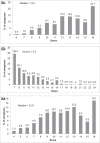The impact of caregiving on caregivers of older persons and its associated factors: a cross-sectional study
- PMID: 31423540
- PMCID: PMC7905146
- DOI: 10.11622/smedj.2019100
The impact of caregiving on caregivers of older persons and its associated factors: a cross-sectional study
Abstract
Introduction: Many older people rely on caregivers for support. Caring for older people can pose significant burdens for caregivers yet may also have positive effects. This study aimed to assess the impact on the caregivers and to determine factors associated with caregivers who were burdened.
Methods: This was a cross-sectional study of 385 caregivers of older people who attended a community clinic in Malaysia. Convenience sampling was employed during the study period on caregivers who were aged ≥ 21 years and provided ≥ 4 hours of unpaid support per week. Participants were asked to complete a self-administered questionnaire, which included the Carers of Older People in Europe (COPE) index and the EASYCare Standard 2010 independence score. The COPE index was used to assess the impact of caregiving. A highly burdened caregiver was defined as one whose scores for all three COPE subscales were positive for burden. Care recipients' independence was assessed using the independence score of the EASYCare Standard 2010 questionnaire. Multiple logistic regression was used to determine the factors associated with caregiver burden.
Results: 73 (19.0%) caregivers were burdened, of whom two were highly burdened. Caregivers' median scores on the positive value, negative impact and quality of support scales were 13.0, 9.0 and 12.0, respectively. Care recipients' median independence score was 18.0. Ethnicity and education levels were found to be associated with caregiver burden.
Conclusion: Most caregivers gained satisfaction and felt supported in caregiving. Ethnicity and education level were associated with a caregiver being burdened.
Keywords: EASYCare; burden; caregivers; quality of life; standard of care.
Copyright: © Singapore Medical Association.
Figures
References
-
- UNFPA, HelpAge. International Ageing in the Twenty-First Century:A Celebration and a Challenge. New York: UNFPA and HelpAge International; 2012.
-
- Mat R, Taha HM. Presented at the 21st Population Census Conference, 19-21 November. Kyoto, Japan: 2003. [Accessed December 5 2013]. Socio-economic characteristics of the elderly in Malaysia. Available at: https://tongkk.files.wordpress.com/2013/09/malaysia.pdf .
-
- Zawawi R. Active ageing in Malaysia. Presented at the Second Meeting of the Committee on International Cooperation on Active Ageing, 19 July. 2013. [Accessed January 4 2014]. Tokyo, Japan. Available at: http://www.mhlw.go.jp/stf/shingi/2r98520000036yla-att/2r98520000036yqa_1... .
-
- Poi PJ, Forsyth DR, Chan DK. Services for older people in Malaysia:issues and challenges. Age Ageing. 2004;33:444–6. - PubMed
-
- Walker A, Guillemard AM, Alber J. Older people in Europe:social and economic policies. The 1993 Report of the European Observatory. Brussels:Commission of the European Committees. 1993. Available at: http://aei.pitt.edu/58285/1/A7962.pdf. Accessed December 20 2013.
MeSH terms
LinkOut - more resources
Full Text Sources
Medical


